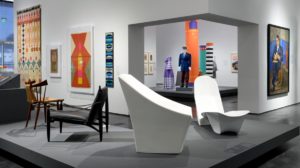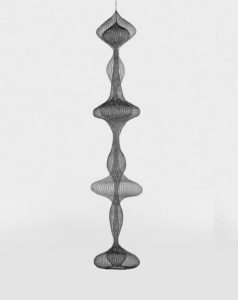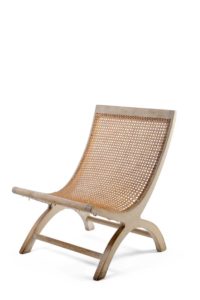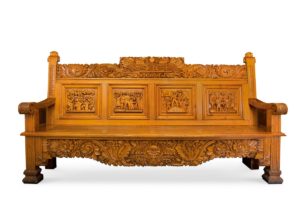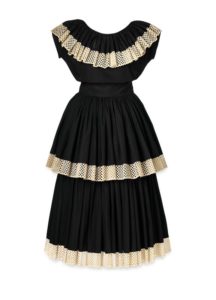Lasting Impressions in LA from Found in Translation
Over 250 objects were assembled at the Los Angeles County Museum of Art (LACMA) from September 2017 through April 2018 to unravel the intricacies of the longstanding and complex relationship between Mexican and Californian design. Exploring the rich and diverse design discourses happening in these two places across the 20th century, Found in Translation: Design in California and Mexico 1915–1985 was built around four main topics: Spanish Colonial Inspiration, Pre-Hispanic Revivals, Folk Art and Craft Traditions, and Modernism (Figure 1). Each theme was examined through an abundance of material culture, ranging from ceramic mosaic tapestries to traditional Mexican folk dresses, in addition to a wealth of other materials illustrating the constant exchange of art, ideas, literature, and architecture.
Beginning with Spanish Colonial Inspiration and ending with Modernism, the exhibition demonstrated that the connections between these eras are as deep and as prevalent then as they are now. Mexico and California have always shared a “Spanish past” and over the centuries this concept served as a launch pad as they both sought out their own unique identity, creating an overlap in the creative efforts of each place. While many Mexican artisans focused their attentions to California as a paragon of modernity following the Second World War, Californians looked to Mexico as a way to regionally distinguish themselves through the incorporation of Spanish Colonial revival designs. This intersection thereby created an influx of artists, designers, and craftspeople sharing and trading styles across the border.
The show also shed light on the more complicated and often-overlooked connections between Mexico and California. For example, the exhibition featured the work of Ruth Asawa (1926–2013), an Asian American artist from San Francisco, who was known for employing traditional Mexican basket-weaving methods to create whimsical wire sculptures (Figure 2). Other links between Asawa and Mexico are expressed through a painted butaca chair, made by her friend Clara Porset, a Cuban émigré whom she met while taking a class on household crafts and domestic architecture at the Universidad Nacional Autónoma de México in 1945 (Figure 3). The designs of these two craftswomen expose layers of expansive artistic networks and parse out the complexities of artistic exchange.
Other highlights from the exhibition included an intricately crafted bench by Xavier Guerrero, Amado de la Cueva, and Juan Hernández that depicts ideals about the Mexican Revolution paired with pre-Hispanic imagery (Figure 4). The bench formerly resided in Casa Zuno, the home of Guadalupe Zuno, Governor of Jalisco (1923–26), where modern and “Americanized” elements intermingled. An Agnes Barrett garment also proved to be a standout in the galleries (Figure 5). Her black dress with white ruffles is in the style of the china poblana, a traditional Mexican frock worn for special occasions by working class females beginning in the early 19th century. Barnett, a highly-influential American fashion designer known for her sportswear creations, designed this dress in 1940 as a celebration of Hispanic history in California and Mexico.
Found in Translation: Design in California and Mexico 1915–1985 left a lasting impact on the surrounding community and to the many who visited the exhibition, as well as through LACMA’s permanent collections. As Staci Steinberger, the Museum’s Assistant Curator of Decorative Arts and Design noted, the show encouraged multiple departments to collect in new areas. Numerous acquisitions were made specifically for Found in Translation, ranging from the expansion of their graphic design collection to include the work of local artists whose talents were featured prominently in the exhibition, such as the California-based Mid-Century designers, Evelyn and Jerome Ackerman.
Other departments aided in decisions about the show as well. Described as an “All hands-on-deck effort” by Steinberger, Found in Translation’s success was a result of the insights provided by curatorial teams across LACMA. Given the large scope of the exhibition, which incorporated works from the departments of Latin American art, costume and textiles, photography, the ancient Americas, and decorative arts and design, such cooperation was essential. The diversity of the objects in the show and the experts who interpreted them provided thought-provoking dialogues about the importance of the designers, artists, and craftspeople who created bridges between California and Mexico.
While Found in Translation was about two places, there is no doubt that the show placed a large emphasis on the unique aura of LA and how the city is characterized by its synthesis of Mexican and Californian design and architecture. This accentuation was in great part due to Pacific Standard Time (PST), the initiative that sponsored Found in Translation. PST is spearheaded by the Getty and focuses on creating connections between the history of art and Southern California. Since its first installment in 2011, PST has become a defining hallmark of the region’s art scene. This past year marked the program’s third chapter with the theme “LA/LA,” which aimed to showcase the Latin American experience in Los Angeles. Over 70 museums and art galleries in the Southern California participated, but Found in Translation stood out above the ranks.
If you were unable to see this truly spectacular show during its run at LACMA, do not despair. Although the exhibition is no longer on view, many works are still accessible. Murals and architecture played an important role in telling the story of Found in Translation and were referenced in the show. Steinberger suggests that these immovable elements were some of the best pieces from Found in Translation and are scattered throughout the Los Angeles area for visitors and locals alike to continue to explore.
Over 250 objects were assembled at the Los Angeles County Museum of Art (LACMA) from September 2017 through April 2018 to unravel the intricacies of the longstanding and complex relationship between Mexican and Californian design. Exploring the rich and diverse design discourses happening in these two places across the 20th century, Found in Translation: Design in California and Mexico 1915–1985 was built around four main topics: Spanish Colonial Inspiration, Pre-Hispanic Revivals, Folk Art and Craft Traditions, and Modernism (Figure 1). Each theme was examined through an abundance of material culture, ranging from ceramic mosaic tapestries to traditional Mexican folk dresses, in addition to a wealth of other materials illustrating the constant exchange of art, ideas, literature, and architecture.
Beginning with Spanish Colonial Inspiration and ending with Modernism, the exhibition demonstrated that the connections between these eras are as deep and as prevalent then as they are now. Mexico and California have always shared a “Spanish past” and over the centuries this concept served as a launch pad as they both sought out their own unique identity, creating an overlap in the creative efforts of each place. While many Mexican artisans focused their attentions to California as a paragon of modernity following the Second World War, Californians looked to Mexico as a way to regionally distinguish themselves through the incorporation of Spanish Colonial revival designs. This intersection thereby created an influx of artists, designers, and craftspeople sharing and trading styles across the border.
The show also shed light on the more complicated and often-overlooked connections between Mexico and California. For example, the exhibition featured the work of Ruth Asawa (1926–2013), an Asian American artist from San Francisco, who was known for employing traditional Mexican basket-weaving methods to create whimsical wire sculptures (Figure 2). Other links between Asawa and Mexico are expressed through a painted butaca chair, made by her friend Clara Porset, a Cuban émigré whom she met while taking a class on household crafts and domestic architecture at the Universidad Nacional Autónoma de México in 1945 (Figure 3). The designs of these two craftswomen expose layers of expansive artistic networks and parse out the complexities of artistic exchange.
Other highlights from the exhibition included an intricately crafted bench by Xavier Guerrero, Amado de la Cueva, and Juan Hernández that depicts ideals about the Mexican Revolution paired with pre-Hispanic imagery (Figure 4). The bench formerly resided in Casa Zuno, the home of Guadalupe Zuno, Governor of Jalisco (1923–26), where modern and “Americanized” elements intermingled. An Agnes Barrett garment also proved to be a standout in the galleries (Figure 5). Her black dress with white ruffles is in the style of the china poblana, a traditional Mexican frock worn for special occasions by working class females beginning in the early 19th century. Barnett, a highly-influential American fashion designer known for her sportswear creations, designed this dress in 1940 as a celebration of Hispanic history in California and Mexico.
Found in Translation: Design in California and Mexico 1915–1985 left a lasting impact on the surrounding community and to the many who visited the exhibition, as well as through LACMA’s permanent collections. As Staci Steinberger, the Museum’s Assistant Curator of Decorative Arts and Design noted, the show encouraged multiple departments to collect in new areas. Numerous acquisitions were made specifically for Found in Translation, ranging from the expansion of their graphic design collection to include the work of local artists whose talents were featured prominently in the exhibition, such as the California-based Mid-Century designers, Evelyn and Jerome Ackerman.
Other departments aided in decisions about the show as well. Described as an “All hands-on-deck effort” by Steinberger, Found in Translation’s success was a result of the insights provided by curatorial teams across LACMA. Given the large scope of the exhibition, which incorporated works from the departments of Latin American art, costume and textiles, photography, the ancient Americas, and decorative arts and design, such cooperation was essential. The diversity of the objects in the show and the experts who interpreted them provided thought-provoking dialogues about the importance of the designers, artists, and craftspeople who created bridges between California and Mexico.
While Found in Translation was about two places, there is no doubt that the show placed a large emphasis on the unique aura of LA and how the city is characterized by its synthesis of Mexican and Californian design and architecture. This accentuation was in great part due to Pacific Standard Time (PST), the initiative that sponsored Found in Translation. PST is spearheaded by the Getty and focuses on creating connections between the history of art and Southern California. Since its first installment in 2011, PST has become a defining hallmark of the region’s art scene. This past year marked the program’s third chapter with the theme “LA/LA,” which aimed to showcase the Latin American experience in Los Angeles. Over 70 museums and art galleries in the Southern California participated, but Found in Translation stood out above the ranks.
If you were unable to see this truly spectacular show during its run at LACMA, do not despair. Although the exhibition is no longer on view, many works are still accessible. Murals and architecture played an important role in telling the story of Found in Translation and were referenced in the show. Steinberger suggests that these immovable elements were some of the best pieces from Found in Translation and are scattered throughout the Los Angeles area for visitors and locals alike to continue to explore.

